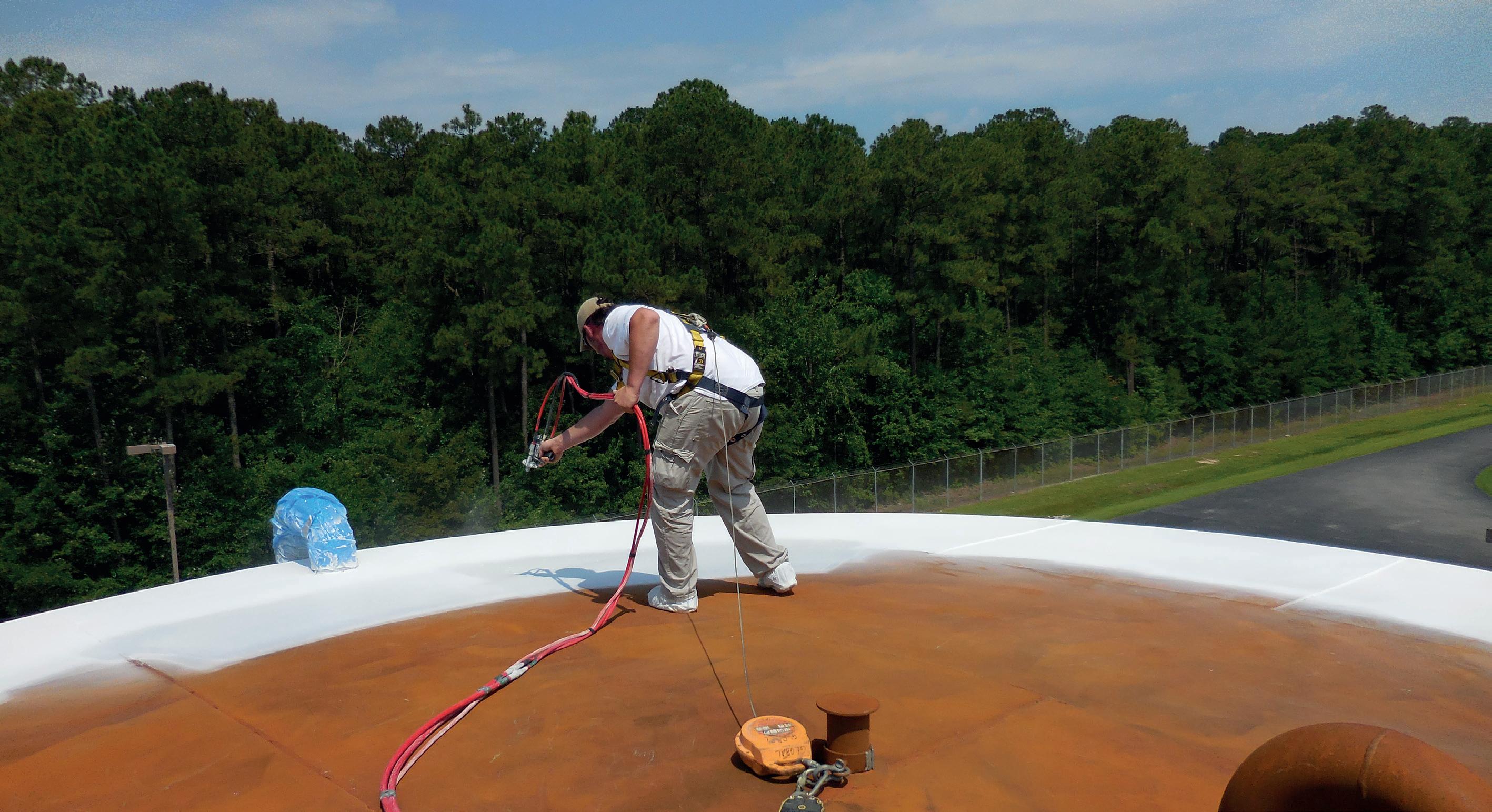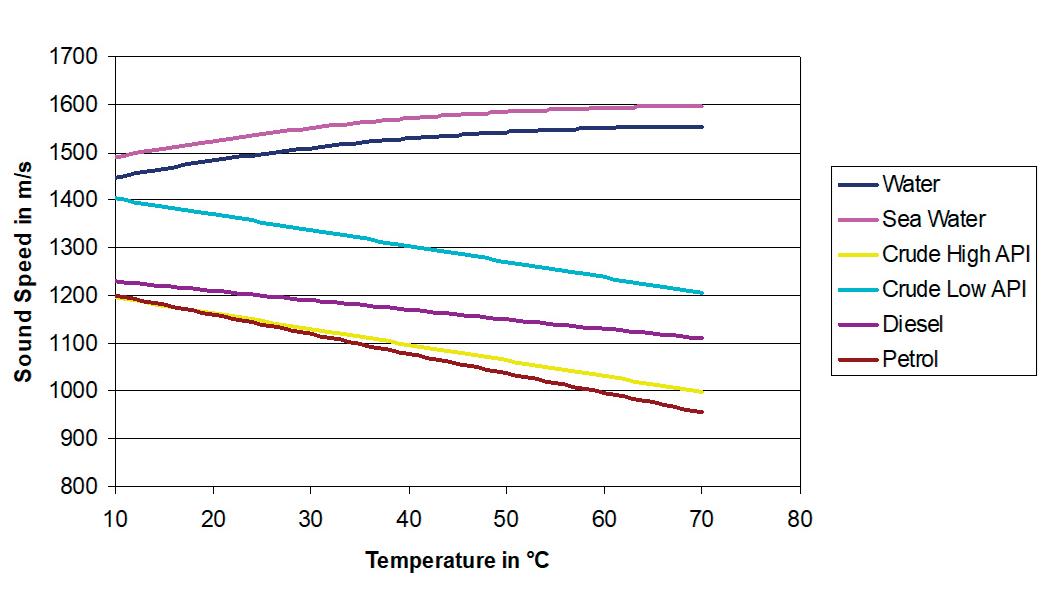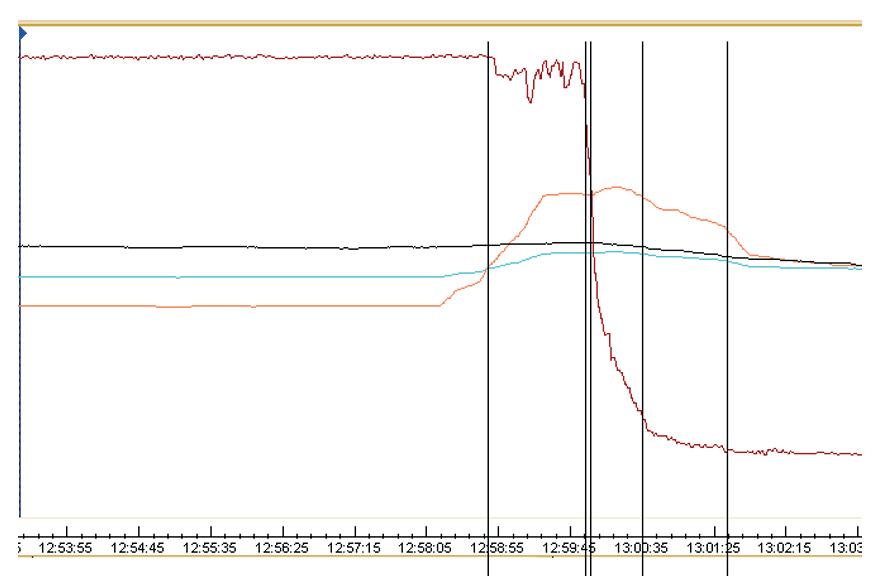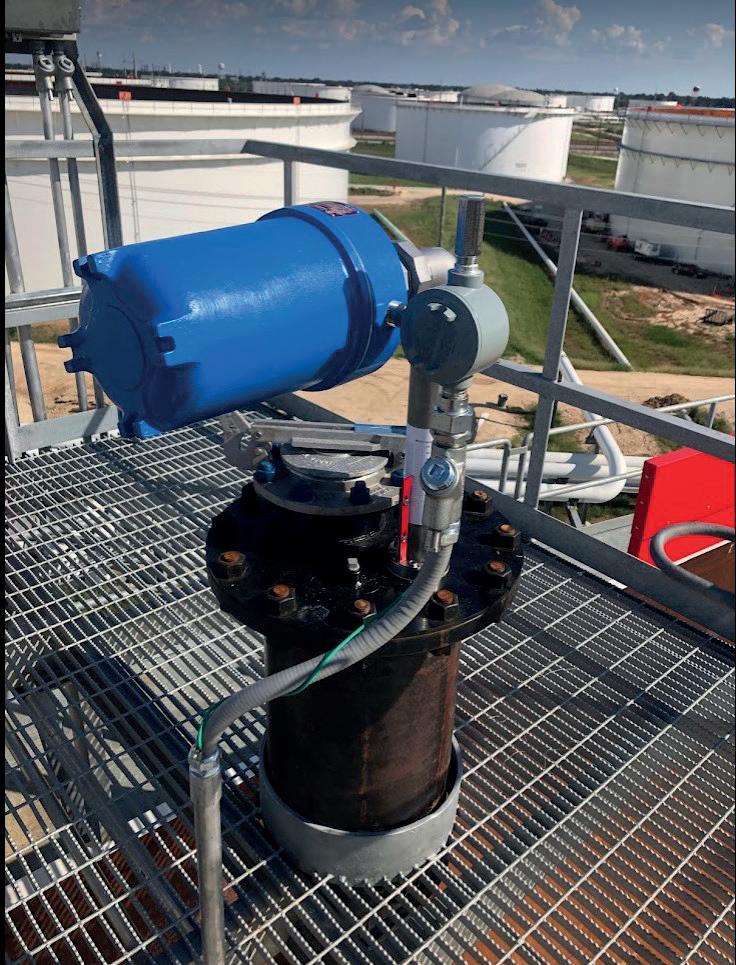
9 minute read
Acoustic distinction
Figure 3. Worker applying EonCoat to a tank roof.
Surprisingly, the coating that performed so well on the corrosion test had zero HAPs, zero toxins, zero VOCs, no isocyanates, and no heavy metals (including zinc). In addition, the coating is not flammable and does not create greenhouse gas.
As such, the most effective corrosion coating tested is also the safest for the environment and workers. The coating also offers monetary benefits as it reduces the cost of lost time and productivity, medical treatment, early retirement, falls and errors.
The solution
The breakthrough technology, Chemically Bonded Phosphate Ceramics, can be applied directly to surface rust. It only requires one coat and will provide corrosion protection for the lifetime of the asset. It is not only safe for the environment, but perhaps most importantly, it is also safe for workers. An unexpected benefit is that it is also less expensive to apply and takes about half the time.
Implications for the downstream sector
This technology has been used for 10 years, with at least eight years in downstream applications. There are versions of the technology tailored to applications that are specific to the downstream sector.
The atmospheric version, such as the one NASA tested, is used for the exterior of tanks in refineries and petrochemical plants in many locations. That same coating is used on structural steel, including offshore platforms.
There is also a corrosion under insulation (CUI) version of the coating, which can handle up to 500˚C and is in use on both insulated tanks and pipelines in many downstream facilities.
The most recent development of Chemically Bonded Phosphate technology is a weldable version. It is possible to weld on one side of a plate without damaging the coating next to the weld or the coating on the other side of the plate. The first use of this coating was on the soil-facing side of oil and chemical storage tanks. Welded tank bottoms will no longer rust out from soil-side corrosion – now they can be protected, with or without cathodic protection.
Need a reprint?


We can tailor to your requirements, produce 1 - 12 page formats, print colour or mono and more

Carolina Stopkoski, FLEXIM AMERICAS Corp., and Jörg Sacher, FLEXIM GmbH, discuss the benefits of using non-invasive sound speed measurements to improve tank dewatering operations.

Along the entire value chain of the oil and gas industry, water is an undesirable companion. Not only does it degrade the quality of hydrocarbon products, but it also presents enormous risks of damaging assets by corrosion and severely disturbing operations. Therefore, removing water from oil is of primary importance, from production through to transport, and storage through to refining.
The separation process in a typical tank farm is rather unsophisticated. Its principal agent is time, and a water-oil emulsion will separate in the tank. Due to its higher density, water sinks to the bottom and a dirty separation layer – the so-called rag layer – forms between the aqueous and the oily phase. This layer of mixed fluids causes several undesired operational effects. As an emulsion of water and hydrocarbons, it offers ideal conditions for microbial growth, which affects both product quality and the integrity of the tank due to the formation of sludge and corrosion. This means that all tanks need to be dewatered regularly.
Automation relies on measurement
The basic and traditional procedure for tank dewatering is executed manually – one or more valves are opened to drain out the water and are then closed again. Today, due to its evident inefficiency in terms of human labour and imprecise distinction of the media that is required to be separated, this kind of manual operation appears almost anachronistic. It is therefore no wonder that tank farm operators have sought out various means to automate the tank dewatering procedure.
The key component of any automated tank dewatering system is a measuring device to detect the water-oil interface. Conventional solutions use conductivity, capacitance, microwave

Figure 1. Measuring principle of the ultrasonic flowmeter, FLUXUS.

Figure 2. Sound speed of water and some crude and refined hydrocarbons.

Figure 3. Sound speed measurement allows for precise real-time monitoring of the dewatering process, including the rag layer.
Figure 4. Sound speed measuring point at an automated tank dewatering system with clamp-on ultrasonic transducers. or optical measurements for this purpose. Such devices not only have a high purchase price, but the installation work is also costly, as insertions into a pipe or into the tank itself are necessary. Welding presents the risk of affecting tank integrity. Furthermore, these wetted measuring solutions have severe shortcomings, as they come in direct contact with the fluid and are affected by dirt build-up. As a result, they require frequent maintenance, which impacts the availability of the respective storage tank.

Clamp-on ultrasonic measurement
Non-invasive sound speed measurement with clamp-on ultrasonic technology provides a simple solution for this task. When FLEXIM was founded by four university graduates in 1990 in Berlin, Germany, its initial key application was – and still is – non-invasive flow measurement. As ultrasonic signals travel faster in the direction of a flowing medium than against it, the difference between their transit times can be measured. Computation of the geometry of the measuring point and physical properties of the fluid allows for precise calculation of volume or mass flow.
Since then, FLEXIM’s ultrasonic flowmeters, FLUXUS, have been proven as an excellent solution for countless applications, be it monitoring the flow of medical oxygen in hospitals, measuring production rates at oil and gas wells onshore and offshore, or quantifying steam flow in industrial production or heating applications.
The technology can also be used for analytical purposes. Exactly the same arrangement of clamp-on ultrasonic transducers mounted onto the outside of a pipe allows the meter to determine the acoustic velocity in the medium. This depends on the density – and therefore the temperature – of the medium, and is a substance-specific characteristic.
Consequently, the speed of sound can be used to distinguish between mediums, and even to identify them. In the oil and gas industry, this methodology is used to distinguish and identify different hydrocarbons that flow successively through a multi-product pipeline. Another common application of sound velocity measurement is to protect chemical tanks from dangerous misfilling. As the speed of sound of a substance depends strongly on its molecular structure, acids and alkalis, for example, can be very clearly distinguished from each other.
Water-oil interface detection
The same applies to the distinction between water and hydrocarbons. The two have clearly different sound velocities, which respond in opposite ways to temperature changes: the speed of sound of water increases with temperature, while that of hydrocarbons decreases. It is therefore very easy to automate tank drainage based on sound velocity measurement. As the clamp-on ultrasonic transducers are simply mounted on the outside of the drainage pipe, setting up the measuring point does not affect the integrity of the tank, nor does it require the pipe to be opened. In addition to this simple and correspondingly cost-effective installation, the non-intrusive acoustic measurement technology has the advantage that the passage of the intermediate layer – the oil-water emulsion – can also be precisely monitored.
Another additional benefit of interface detection with FLUXUS is that the ultrasonic system can also be used
simultaneously for flow measurement. This ensures that the valves are properly closed again after the drainage process has been completed. Additionally, the flow data can be used for tank balancing purposes.
Meeting industry needs
In order to meet the needs of the hydrocarbon industry, FLEXIM has developed an ultrasonic measuring system: the FLUXUS H series. It combines highly precise non-invasive flow measurement with HPI-specific analytical capabilities. Approximately 15 years ago, the first sound speed test measurements were made with FLUXUS flowmeters in tank dewatering operations. Thanks to the promising results, first implementations of the solution soon followed. Since then, the company’s measuring experts have consistently developed the application further, in cooperation with their customers. Today, it is a well-established solution that has become a standard for some of the largest refinery operators worldwide, particularly in the Middle East.
Key benefits
The benefits of tank dewatering automation with clamp-on ultrasonic flow meters can be summarised as follows:
Increased occupational and operational safety
n Acoustic interface detection eliminates human error. n No risk of leakage. n No risk of unwanted and dangerous emissions due to accidental hydrocarbon release.
Increased efficiency, full availability and overall cost reduction
n It can be easily retrofitted to an existing tank layout; no need for piping modifications. n No process interruption during installation and commissioning. n Reduces product losses. n Cost-savings in water treatment through reduced amount of released hydrocarbons. n No direct contact with the medium, resulting in no wear and tear, no drift through dirt, and no wax build-up. n Zero maintenance. n Simultaneous flow measurement allows for process monitoring and tank balancing.
Conclusion
The technology outlined in this article offers a simple solution for the automation of tank dewatering. Measuring from the outside of the pipe means measuring from the safe side. As the ultrasonic transducers do not come into direct contact with the medium flowing inside, they do not suffer wear and tear. Automated tank dewatering increases safety and improves operations, which has an immediately-positive impact on the operator’s bottom line.
Page Number | Advertiser

IFC | ATEC Steel
17 | AUMA
OBC | Gauging Systems Inc.
25 | GEA
35 | Gerotto
47 | ILTA
10 | METCORE International Pte Ltd
AD INDEX
04 | Midwest Steel
43 | NISTM
21, 26, 39, 44 & IBC
| Palladian Publications
OFC & 13 | Paratherm
14 | REMBE® GmbH Safety + Control
09 | Trinity Consultants | BREEZE
02 | Zwick Armaturen GmbH
The premier source of technical and analytical information for the renewable energy industry, covering solar, wind, bioenergy and storage.

Correct Inventory and Liquid Loss Control
• From a tank gauge (It’s not Radar, Servo, Magnetostrictive, etc.) Bottom referenced (Innage) • Provides the most accurate product volume (Inventory) (Transfer Ticketing) • Provides Overfill Protection beyond API 2350
Standard, 5th Edition • Provides Rupture Protection for Over Pressure & Vacuum on CRT’s • Provides Leak Detection (Tank tightness,
Historical) and Unauthorized Movement • Provides Vapor Monitoring (Optional ambient vapor monitoring) • Provides Product Quality by continuous monitoring of product stratification over the height of the liquid (Water, Density, & Temperature) (Blending, De-watering,
Sampling Top-Middle-Bottom in real-time, etc.) • And provides this data to any system via a closed server with OPC/UA, PI,
SAP, MQTT, Back Office, etc. connectivity (Real-time or Scheduled) • TG Soft Server supports multiple applications that are tailored to providing a payback and profit from your gauging technology. What data do you need?












